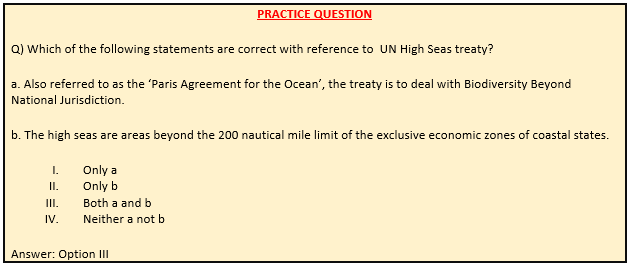Description

Copyright infringement not intended
Context: A new round of negotiations on the much-awaited United Nations High Seas Treaty for conservation and sustainable use of marine biological diversity of areas beyond national jurisdiction (BBNJ) began in New York February 20, 2023.
Details:
- The two-week meeting resumed after member nations failed to reach a consensus on the treaty at the fifth session of the Intergovernmental Conference (IGC) on the BBNJ in August 2022.
- The high seas are areas beyond the 200 nautical mile limit of the exclusive economic zones of coastal states.
- Home to around 270,000 species, the high seas cover more than two-thirds of the global ocean.
- Over 1,550 marine animals and plants face a risk of extinction, with climate change impacting at least 41 per cent of threatened marine species
- Only 1.44 per cent of the high seas are protected.
- The legally binding treaty, if adopted, will safeguard global ocean health, climate resilience, socio-economic well-being and food security for millions of people.
.jpeg)
Sharing of MGRs:
- Member states discussed an important element under the treaty: The benefit sharing of marine genetic resources (MGRs).
- It includes marine plants, animals and microbes from areas beyond national jurisdiction.
- The element aims to address the inequalities in sharing benefits from samples, basic and applied research results as well as monetary benefit sharing from MGRs.
What is the proposed UN High Seas treaty?
- Also referred to as the ‘Paris Agreement for the Ocean’, the treaty to deal with Biodiversity Beyond National Jurisdiction has been under discussion for several years.
- The proposed treaty concerns the ocean existing beyond the Exclusive Economic Zones that lie from the coast of a country to about 200 nautical miles or 370 km into the sea, till where it has special rights for exploration.
- Waters beyond that are known as open seas or high seas.
- The treaty was to be negotiated under the United Nations Convention on Laws of the Sea (UNCLOS) of 1982 which governs the rights of countries regarding marine resources.
- As there is no treaty for conserving the health of vast swathes of the earth’s oceans, a UN resolution in 2017 had decided to rectify this while setting 2022 as the deadline.
- The pandemic resulted in many delays, and later, a High Ambition Coalition, which now has more than 100 countries including India, the US, and the UK, came about and put the focus on ‘30×30’ goals – protecting 30% of the ocean by 2030. After the latest deadlock, talks will only resume next year, unless a special session is called.
- Some aspects of negotiations included establishing marine protected areas to put limits on certain activities, environmental impact assessments or clearances for sustainability of works, financial support to countries and sharing other scientific knowledge. The
- International Union for Conservation of Nature has said binding agreements are needed for this treaty to be effective.
About United Nations Convention on Biological Diversity (CBD)
- CBD is a legally binding Conventionrecognized for the first time, that the conservation of biological diversity is “a common concern of humankind” and is an integral part of the development process.
- The agreement covers all ecosystems, species, and genetic resources.

Objectives:
- The conservation of biodiversity
- Sustainable use of the components of biodiversity
- Sharing the benefits arising from the commercial and other utilization of genetic resources in a fair and equitable way
- It acknowledges that substantial investments are required to conserve biological diversity.
Further read: https://www.iasgyan.in/daily-current-affairs/biodiversity-in-areas-beyond-national-jurisdiction


https://www.downtoearth.org.in/news/governance/fresh-negotiations-on-un-high-seas-treaty-begin-in-new-york-here-s-what-to-expect-87830













